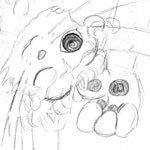Dec 27, 2008
Mushi-shi.
This isn't an anime series like many others, the closest to describe it would be a Studio Ghibli movie in serial form, perhaps. It is comparable there, in the ethereal and inventive and spiritual nature of the plot, which centers on the beings called mushi, and those who study them, more specifically, Ginko, a man that always seems out of place compared with everyone else.
While every character in this series, other Mushi-Shi included, usually dresses in classic traditional japanese attire, he seems to wear western shirts and clothing. While the character designs of every other character is apparently made to look as down to earth
...
and, well, realist, as possible - while definitely not lacking a certain charme and beauty, indeed , I found them an extremely nice change of pace from all those ridiculously colored punk hairdos you see so often in other anime that they totally lost any kind of rareness appeal to me - Ginko has green eyes and white hair.
However, most of the time, Mushi-shi puts the humans into the center spot of the plot, even though everything is connected to the Mushi, it's all about human plights and people's reactions to them. Sometimes with rage and fear, sometimes more gently, but either way, the only one seemingly unaffected seems to be Ginko, altough even he is portrayed as a genuine human being with his faults and sometimes his emotions overpower him as well, although he seems like a serene wise most of the time.
The art in Mushi-shi is barely comparable. And not just the visuals, it ties together with the sound, the chiming, eerie music that usually plays when mushi-shi appear, the long camera pans and scenes that simply showcase the silent landscape and nature, and the visual effects, especially, again, when the mushi appear.
As previously mentioned the character designs seem simple, but each person is different enough not to be confused with any other, and although black hair and a certain look prevails, that's intended to showcase that yes, this is indeed ancient japan, not out of a lack of creativity.
The individual episodic plots are quite nice, the only downside to it all is, of course, that you do not have an overarching story, except perhaps how you get a closer and more succinct picture of Ginko's character and heritage. The greatest part of it is definitely the multitude of different mushi, and especially the way they are presented: From the point of view of a society that studies them, it is never said: This is how it is, and those you saw are exactly all mushi that exist, on the contrary, it summons a vivid idea of billions and billions of mushi that exist in Mushi-Shi's world but simply have not appeared, and although the focus is on Ginko, it also showcases a few other Mushi-Shi, all seemingly weird, special and unique. It even has some interesting ideas about how an organisation like theirs could work, being without apparent hierarchy and all.
But the most important thing - and the one that made me compare it to Studio Ghibli, besides the fun and amorphous spirits that oh so frequently feature there - is the fact that you really feel: Someone put all his love into this work. Every single scene seems to tell me this, the charming characters, who are all too human with their problems and their reactions, the ethereal mushi, the landscape: It all seems to be crafted with utmost care.
The slow english intro theme is just as unique, and seems to express the mood of Mushi-Shi perfectly:
Slightly melancholic, filled with love, speaking of long journeys and the small but very important moments of peace and happiness that make life worthwhile.
I could probably write pages more of praise of this, in one way or ther other, but in brief:
This is the stuff that makes me realise why I like to watch anime so much.
Reviewer’s Rating: 10
What did you think of this review?
Nice
 0
0
Love it
 0
0
Funny
 0
0
Confusing
 0
0
Well-written
 0
0
Creative
 0
0Show all
